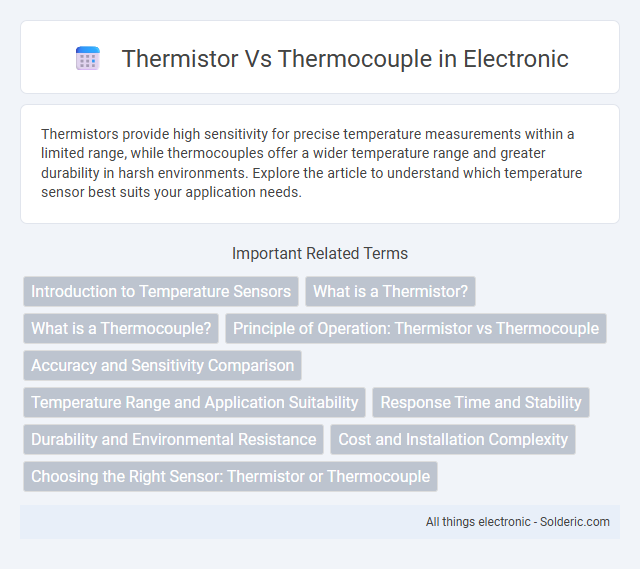Thermistors provide high sensitivity for precise temperature measurements within a limited range, while thermocouples offer a wider temperature range and greater durability in harsh environments. Explore the article to understand which temperature sensor best suits your application needs.
Comparison Table
| Feature | Thermistor | Thermocouple |
|---|---|---|
| Temperature Range | -50degC to 150degC | -200degC to 1750degC |
| Accuracy | +-0.1degC to +-2degC | +-1degC to +-5degC |
| Sensitivity | High | Moderate |
| Response Time | Fast | Fast |
| Durability | Fragile, sensitive to mechanical stress | Robust, withstands harsh environments |
| Output Signal | Resistance change | Voltage generated by thermoelectric effect |
| Cost | Low to moderate | Low |
| Applications | Medical devices, HVAC, small electronics | Industrial, kilns, gas turbines, engines |
Introduction to Temperature Sensors
Thermistors and thermocouples are widely used temperature sensors critical for precise thermal measurement across industries. Thermistors, made from ceramic materials, exhibit a significant change in resistance with temperature, offering high sensitivity for narrow temperature ranges. Thermocouples consist of two dissimilar metal wires producing a voltage proportional to temperature difference, enabling wide-range and rapid temperature sensing applications.
What is a Thermistor?
A thermistor is a temperature-sensitive resistor made from ceramic or polymer materials that exhibit a significant change in resistance with temperature variations. It is commonly used for precise temperature measurements and control in electronic devices due to its high sensitivity and fast response time. Thermistors are classified into Negative Temperature Coefficient (NTC), where resistance decreases as temperature rises, and Positive Temperature Coefficient (PTC), where resistance increases with temperature.
What is a Thermocouple?
A thermocouple is a temperature measurement device consisting of two different metal wires joined at one end, generating a voltage proportional to the temperature difference between the junction and the other ends. Known for their wide temperature range and fast response time, thermocouples are widely used in industrial applications for monitoring and controlling high-temperature processes. Your choice of a thermocouple ensures accurate and reliable temperature readings in harsh environments where other sensors might fail.
Principle of Operation: Thermistor vs Thermocouple
Thermistors operate based on the principle of resistance change with temperature variations, where their resistance decreases (NTC) or increases (PTC) predictably as temperature shifts. Thermocouples generate a voltage difference at the junction of two dissimilar metals due to the Seebeck effect, directly correlating to the temperature gradient. Selecting between a thermistor and a thermocouple depends on the temperature range, accuracy requirements, and response time relevant to your application.
Accuracy and Sensitivity Comparison
Thermistors provide higher sensitivity and greater accuracy in measuring small temperature changes due to their significant resistance variation with temperature, making them ideal for precise temperature control. Thermocouples, while generally less sensitive, excel in operating across a wider temperature range and harsh environments, offering reliable measurements where thermistors may fail. Your choice depends on whether you prioritize high precision in a narrow range or robust performance in extreme conditions.
Temperature Range and Application Suitability
Thermistors are best suited for precise temperature measurements within a limited range, typically between -55degC and 150degC, making them ideal for applications like medical devices and HVAC systems. Thermocouples operate effectively over a much broader temperature range, from -200degC up to 2500degC, suitable for high-temperature industrial processes such as furnaces and engines. The choice between thermistor and thermocouple depends primarily on the required temperature range and environment specificity for accurate sensing.
Response Time and Stability
Thermistors offer faster response times due to their smaller size and higher sensitivity, making them ideal for applications requiring quick temperature detection. Thermocouples provide greater stability and durability over a wider temperature range, suitable for harsh environments and long-term use. When selecting between the two, consider your need for rapid response versus stable readings in extreme conditions.
Durability and Environmental Resistance
Thermocouples exhibit superior durability and environmental resistance compared to thermistors, functioning effectively in extreme temperatures up to 1800degC and harsh conditions like high humidity, vibration, and corrosive environments. Thermistors, while highly accurate, typically operate within a limited temperature range (-55degC to 150degC) and are more susceptible to damage from mechanical stress and chemical exposure. Your choice should consider the operating environment; thermocouples are ideal for industrial applications requiring robust, long-lasting sensors, whereas thermistors suit controlled settings with less demanding conditions.
Cost and Installation Complexity
Thermistors generally offer a lower cost compared to thermocouples, making them an economical choice for temperature sensing in many applications. Their installation is simpler due to smaller size and ease of wiring, requiring minimal additional components. If your project demands budget-friendly and straightforward setup, thermistors can be more advantageous than thermocouples despite thermocouples handling higher temperatures more robustly.
Choosing the Right Sensor: Thermistor or Thermocouple
When selecting a temperature sensor, thermistors offer high sensitivity and accuracy for precise measurements within a limited temperature range, typically from -50degC to 150degC. Thermocouples are ideal for extreme temperatures, capable of measuring from -200degC to over 1750degC, making them suitable for industrial and high-temperature applications. Choosing between a thermistor or thermocouple depends on the required temperature range, accuracy, response time, and environmental conditions.
thermistor vs thermocouple Infographic

 solderic.com
solderic.com